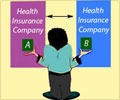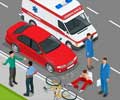
Homeless men, women and families also have significantly more doctors' appointments and higher hospitalization rates, according to research led by Dr. Stephen Hwang of the Centre for Research on Inner City Health at St. Michael's Hospital in Toronto. A small subset of homeless people are extremely frequent users of health services.
Dr. Hwang's findings were published today in three papers in a special issue of the American Journal of Public Health devoted to homelessness and public health, one looking at the overall health care use by homeless people and two others examining factors that can predict frequent ED use or hospitalizations. All three papers used data from the Institute for Clinical Evaluative Sciences, where Dr. Hwang is an adjunct scientist.
Dr. Hwang said that while homeless people are known to have higher rates of chronic and acute health conditions than the general population, no comprehensive assessment of their health care use has been done previously. This information is difficult to obtain in the United States, where more than half of homeless adults lack health insurance, and previous studies were based on single health care institutions or homeless people self-reporting their health care use.
His study is unique because it followed 1,165 people over four years on average in Toronto, where there is universal, government-funded health insurance, and comprehensive databases that capture all doctors, ED and hospital visits. The homeless people, recruited from shelters and meal programs, were compared with low-income people in the general population of the same age and gender.
He said his study has important policy implications for the delivery of health services, especially given recent legislative changes that expanded Medicaid coverage to low-income Americans. Traditionally, a lack of health insurance has been identified as a significant barrier to obtaining ambulatory care in the United States, resulting in unnecessary ED visits and avoidable hospitalizations.
Advertisement
The study found:
- 95.5 per cent of homeless people had at least one encounter with health services during the four-year study (92.5 per cent visited a physician's office, 76.6 per cent visited an ED, 19.5 per cent were hospitalized in a medical-surgical bed and 11.5 per cent were hospitalized in a psychiatric bed).
- By comparison, 84.2 per cent of people in the general low-income population of Toronto had at least one encounter with health services during the four-year study (83.8 per cent visited a physician's office, 35.6 per cent visited an ED, 7.1 per cent were hospitalized in a medical-surgical bed and 1.6 per cent were hospitalized in a psychiatric bed).
- Homeless people had an average of 9.1 encounters a year with ambulatory care (1.76 times higher than the general population), two visits a year to the ED (8.48 times higher), 0.2 medical-surgical hospitalizations (4.22 times higher) and 0.1 psychiatric hospitalizations (9.27 times higher). The highest rates of health care use were among single homeless men and women, i.e. those without partners or dependent children.
- A subset of the homeless participants accounted for 43 per cent of total annual ambulatory care encounters, 60.3 per cent of all ED visits, 79.9 per cent of all medical-surgical hospitalizations and 85.9 per cent of all psychiatric hospitalizations, but only comprised 10 per cent of health care users within each type of health care in the sample of homeless adults.
- The top 10 per cent of homeless health care users had an average of 39 encounters per person per year with ambulatory care (the highest being 141.1 encounters, or one encounter every two to three days), 12.1 encounters with EDs (with a high of 104.9), 1.5 encounters with medical-surgical hospitalizations, and 0.8 psychiatric hospitalizations.
- Among the frequent ED users, 49.1 per cent were also frequent users for medical-surgical hospitalization and 40.2 per cent were also frequent users for psychiatric hospitalization. As well, 2.2 per cent were frequent users for both kinds of hospitalizations and 0.9 per cent were frequent users for all four types of health care.
- Compared to the general low-income population of Toronto, the frequent users were 6.59 times more likely to use ambulatory care services, 55.65 times more likely to visit an ED and 55.84 times more likely to be hospitalized in a medical-surgical bed.
"This very high intensity use by a relatively small number of homeless people can have a substantial impact on the health care system," Dr. Hwang said.
Advertisement
Dr. Hwang noted that the vast majority of homeless people who visited an ED had also visited a doctor's office, "contrary to the hypothesis that homeless individuals present to the ED due to a lack of adequate access to primary care."
"For the first time, we have data showing the exact extent to which people who are homeless use health services and how much more they use these services compared to the general population. The study also shows a subset of people who are high users and how much health care use we might avert if we develop interventions for that top 10 per cent."
St. Michael's has two such interventions aimed at helping people with unmet, complex health care needs access health resources in the community: CATCH-Homeless and CATCH-ED, specifically for people who use Emergency Departments frequently, five or more times a year, at least one of those times for a mental health and-or addiction problem. CATCH case managers work with family physicians, psychiatrists and other service providers to support patients' access to such things as medical care and mental health and addiction services.
Source-Eurekalert











